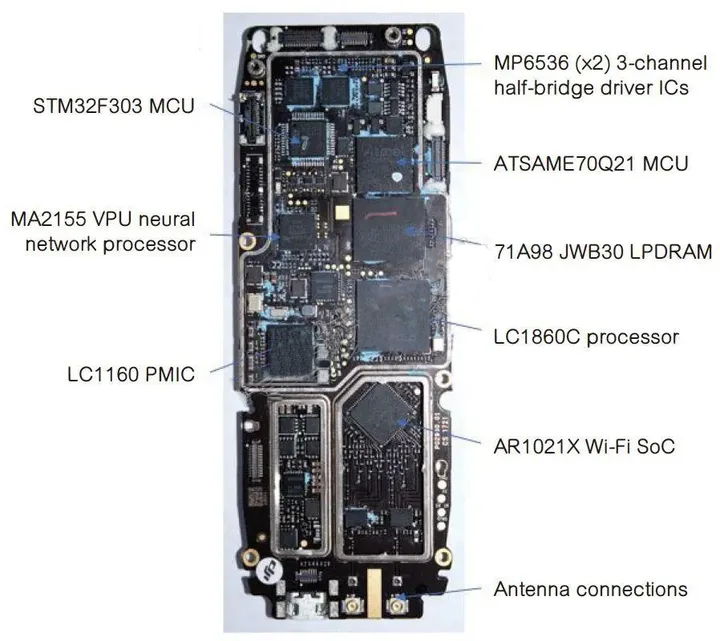This article not only counts the core chips, but also the core control units such as the CPU in the flight control system, as well as key components such as connection devices, sensor devices, and gimbals. Even in some aspects of DJI, except for the CPU, it is completely imported. to solve.
I. Master control
In the field of drones, CPU is necessary (except for toy drones worth dozens of dollars), while the CPU and overall solutions for drones mainly include the flight control system developed by DJI and the drone design provided by Qualcomm. Platform Snapdragon Flight, as well as CPUs used in various solutions based on open source platforms APM, Px4, etc.
1. DJI self-developed flight controller
Some netizens disassembled and found that the nxp lpc1768 used in DJI's early flight control is a consumer-grade 32-bit processor. There may be an FPGA+dsp solution later.
The Spark Xiao released in 2018 uses the Myriad 2 computer vision processing chip of Intel's Movidius for video processing. Later, someone found that it used STMicroelectronics' STM32F303, Intel's Movidius MA2155 VPU, Leadcore's LC1860C SoC, and Atheros/Qualcomm's AR1021X dual-band Wi-Fi SoC.

Mavic Mini uses Ambarella processor for video processing, and someone disassembled Mavic and found that the main control CPU of the flight control chip uses ATMEL's M7 core ATSAME70Q21, with a main frequency of 300MHZ and integrated 2048KB FLASH 384KB RAM.
2. Qualcomm’s Snapdragon Flight platform
The drone design platform Snapdragon Flight launched by Qualcomm in 2015 was mainly used by companies such as Zero Degrees and Puzhou. UAV platforms and chips should have stayed at the architecture and level of 2016.
The Snapdragon chip integrates functions such as wireless communication, sensor integration and spatial positioning. Using "RealSense" technology, it can build a 3D map and perceive the surrounding environment. It can fly like a bat and actively avoid obstacles. The reason why Snapdragon Flight has the most fundamental advantage of being able to lower the manufacturing cost and selling price of drones is because Qualcomm drone chips have the same processor as smartphones, and may also include some other same components, so scale The cost-optimized effect is brought about by automated production; the chip is highly integrated, which saves the combined cost of multiple high-priced modules of the drone. It is reported that the total cost of each module is 30% to 40% of the cost of the drone. Compared with the main drone chip solutions at that time, Qualcomm snapdragon flight has the smallest CPU size and the highest frequency.
However, Qualcomm's chip solution seems to want to have both fish and bear's paw, and coupled with the fierce competition in the drone market, it has not been implemented.
3. The APM open source solution CPU with the second shipment volume: Atmel
The most widely used CPU in the market of APM's open source system is Atmel (Atmel).
Main control: ATMEL MEGA2560 development board. AT91M55800A, ARM7TDMI core, embedded ICE interface, memory and peripherals. Some people say that Atmel's AVR processor chips are widely used in foreign drones, but STMicroelectronics has taken up most of the market in China. In fact, this is not the case. The domestic shipments of flight controllers have reached 100,000+ It is the Atmel CPU using APM.
4. PX4/Pixhawk open source solution
PIXHawk breakthrough uses Cortex-M4 MCU integrated hardware floating-point operation core as the main control chip, built-in two sets of gyroscope and accelerometer MEMS sensors, complement each other for correction, built-in three-axis magnetic field sensor and an external three-axis magnetic field can be connected At the same time, two GPS sensors, one main and one backup, can be connected externally, and can be switched automatically in case of failure. Main controller STM32F427 32-bit microprocessor: 168 MHz, 252 MIPS, Cortex M4 core and floating point unit. The independently powered 32-bit STM32F103 backup fail-safe coprocessor enables manual recovery when the main processor fails.
5. Xiaomi drone platform: Allwinner R16
The first generation of Feimi UAV under Xiaomi has been developed several times. At first, it used Arm chips, but the research and development failed. Later, it cooperated with Allwinner and adopted the Allwinner R16 solution, but it also experienced the first bombing incident. , but it has become relatively stable so far.
II. Other master control schemes
Driven by the special rise of drones, especially the hot consumer drone market in 2015, other manufacturers have launched their own master control solutions, but the actual products and sales are very few, and some are experimental. Including:
1. Leadcore Technology
Leadcore Technology Co., Ltd. is one of the core enterprises of Datang Telecom Technology Industry Group, headquartered in Shanghai, China, specializing in the research and development and application of 2G, 3G, 4G mobile Internet terminal core technologies, providing 3G/4G mobile terminal chips and solutions . Leadcore Technology provides core chip platforms and solutions for personal terminals, home smart terminals, industry application terminals and other products. The product forms cover smart phones, tablet computers, data terminals, wearable devices and other mobile consumer electronics products.
The LC1860 chip, which was officially launched in the third quarter of 2014, is the first domestic 28nm 4G SoC chip for commercial use in the open market, and is an independent and controllable "Chinese chip". In 2016, DJI adopted the Leadcore solution LC 1860 for the first time in its latest generation of consumer-grade aerial photography UAV—DJI Phantom 4. On the man-machine. LC1860 has the characteristics of "4G+28nm", supports LTE-TDD/LTE-FDD/TD-SCDMA/WCDMA/GGE five-mode, integrates 4+1 Cortex A7 1.5GHz CPU, dual-core GPU Mali T628, Trustzone security architecture and other features , is the first domestic 28nm 4G SoC chip for commercial use in the open market.
2. TI (Texas Instruments)
Master control: TI OMAP3630. Micron flash memory, Texas Instruments power management + USB solution, Atheros802.11b/g/nWiFi controller, Bosch BMA150 accelerometer, BMP180 air pressure sensor, IMU-3000 gyroscope and motion processor from Invenstron, PIC24HJ microcontroller from Microchip Technology .
3. SamSung(Samsung)
Master control: Samsung Artik chip. Artik 10 uses a 1.3GHz octa-core processor with 2GB of memory and 16GB of flash memory. Includes Wi-Fi, Bluetooth and Bluetooth Low Energy, ZigBee and Thread. Samsung launched Artik, a low-power chip in May 2015. There are three specifications. Among them, Artik1 is only 12mm*12mm in size and sells for less than US$10. Differences. This chip targets internet-connected devices such as drones and smart furniture. The industry generally believes that Artik will become Samsung's trump card against Qualcomm and Intel, but strictly speaking, Samsung is only a latecomer.
4. NVIDIA (NVIDIA)
Compared with Intel trying to use its processors to enter the drone market to make up for weak PC sales, Nvidia has no reason to enter the drone market urgently. Its core GPU graphics processor business has an annual growth rate of 7%, accounting for 82% of its revenue in the first half of 2016. It is understood that in 2015, Nvidia successively provided chips for Parrot and DJI. For the drone market, Nvidia developed the Jetson TX1 chip solution, which is capable of various image and graphic recognition and advanced artificial intelligence tasks. UAVs using it can be used in Stay in the air longer. Previously, Nvidia also provided chip solutions for DJI and Parrot. Of course, Nvidia did not limit the potential of the TX1 motherboard to the use of drones, it can also be used in robots, Internet of Things devices or laboratory equipment. Nvidia also provides developers with computer vision libraries such as OpenVX1.1 to help developers use the motherboard.
5. Huawei HiSilicon
In the field of drones, HiSilicon, a wholly-owned subsidiary of Huawei, originally had a 70% market share in the security camera market, and then launched the Huawei drone platform in July 2016 in order to add wings to the security camera. Teamed up with Shenzhen's local start-up Zhouxin Technology to launch a series of drone solutions based on Huawei HiSilicon chips.
6. XMOS
XMOS, a European processor manufacturer active in the robot market, also said it has entered the field of drones. At present, the xCORE multi-core microcontroller series of XMOS has been adopted by some OEM customers of UAV/Multicopter. In these systems, XMOS multicore microcontrollers are used both for flight control and for MCU internal communication.
7. Rockchip
Master control: Rockchip RK3288. Rockchip has RK3288-based UAV products displayed and tested in China. According to reports, this drone product uses a four-rotor with a wheelbase of 300mm, based on the Rockchip RK3288 processor, the camera and the fuselage adopt an integrated design, and support 1080p video shooting. The body weight is about 730g, and the battery life is 14 minutes. In terms of functions, it supports one-key panorama, out-of-control return, fixed-point cruise, one-key selfie, one-key fly around, geofencing, etc.
8. Nuvoton
From Taiwan, main controller: Nuvoton MINI5 series. Low-end remote controllers use 4T 8051 N79E814 packaged in SOP20; mid-to-high-end remote controllers use Cortex-M0 M051 series N329 series with built-in ARM9 and H.264 video side decoders.
III. Sensors and Connectors
Sensors are essential devices in UAV flight control. The main core components are basically developed by foreign manufacturers.
1. Bosch
The BMF055 launched by Bosch in 2016 provides a "one-stop" sensor solution, allowing innovators to focus on software development and other more important factors. UAVs developed using the BMF055 sensor can not only fly at high speeds in the air, but even Flip in mid-air.
There are also BMM150 three-axis digital geomagnetic sensor and BMP388 air pressure sensor.
At the Consumer Electronics Show (CES) in Las Vegas, USA in 2018, Bosch Sensortec launched two new sensor products. One of these is the high-performance inertial measurement unit (IMU) BMI088, a six-axis IMU with superior vibration resistance designed for drone and robotic applications.
2. TE
Devices specially used for UAV solutions include: digital air pressure sensors that measure air pressure to convert it into altitude, digital differential pressure sensors for plant protection machines, etc.
MS5607/MS5611 is a digital air pressure sensor that uses the measured air pressure to convert it into altitude. They can resolve an air pressure of 0.012mbar (1.2pa), which is approximately equal to a rise of 10cm (at low altitudes, near sea level), making them ideal for altitude measurements with drones and altimeters.
TE's MS4515DO is a digital differential pressure sensor for airspeed where very low pressure ranges are generally required. Generally, the model of 4515DO gauge pressure will be selected.
3. ALPS
ALPS sensor has a very long-term cooperative relationship with many large domestic manufacturers in the field of drones, including DJI.
It mainly focuses on some existing sensors such as angle sensors, which are used in camera control, and air pressure sensors, including lift-off height automatic pruning products.
4. Hirose
At present, DJI has the largest shipment volume. The solution provided by the drone is mainly the gimbal, one is high-definition, and the other is to ensure the stability of the connection under the premise of vibration. This is Hirose's advantage and mainly focuses on this.
Specifically, it refers to connecting the camera module to the main board, and the camera itself to the center of the gimbal, which needs a high-frequency and high-speed signal that can be rotated. There is a coaxial product with a device line inside, and its RF is a single Make a row.
IV. GPS
The reason why GPS is taken out separately is that even though China now has a large amount of Beidou, which will soon be able to cover the whole world, the most commercialized and practical use is the American GPS, especially in foreign markets, the American GPS standard The core module is indispensable. At the same time, even if GPS can be localized, it still has to rely on the American GPS standard. Therefore, this is also an essential core device in drones.
1. GPS
There are many GPS manufacturers at home and abroad, with multi-mode, there are three choices (US GPS, China Beidou, Russia GLONASS) or even more standard choices, but the core GPS standard is indispensable. On the high end there is differential GPS.
V. Conclusion
It can be seen that most of the core CPU and core components of DJI drones still rely on foreign manufacturers to import. As for why they can’t develop their own, on the one hand, most of China’s drones focus on integration. Another important reason is The reason is that the market is not big enough. The annual sales volume of global consumer drones is only about 1 million units, and that of industrial drones is only 100,000 to 200,000 units. Such a market capacity is still far from being able to meet the cost of hundreds of millions of dollars for self-developed chips, design, tape-out, and production. However, large foreign manufacturers generally have mature design and R&D capabilities, as well as some common or similar chip architectures, and the cost invested in this aspect is relatively small when diluted.
Therefore, in order to solve the self-development of UAV core chips, it is necessary to increase market development and innovation. Although UAVs are currently mainly turned to industry development, the consumer market is always the largest market. Only by solving the problems of the consumer market The pain point is that everyone can play with drones at will, and it is possible to expand to ten times or a hundred times. After all, the global mobile phone market has billions, and the drone market is only more than one million. There is still a lot of room for imagination.
The prosperity of the consumer market will certainly drive the faster development and prosperity of the industrial drone market.

Nantian Electronics a professional distributor of electronic components, providing a wide range of electronic products, saving you a lot of time, effort and cost through our meticulous order preparation and fast delivery service.
Share this post


